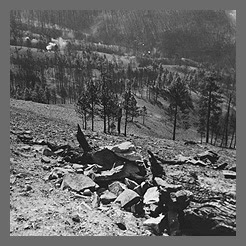 |
Source: Mann Gulch Staff Ride
|
Reflection 1 – Wag Dodge’s Escape Fire during the Mann Gulch Fire:
You are the incident commander on a wildfire located to the east side of the Continental Divide in western Montana on August 5, 1949. You and 15 smokejumpers attack the fire. During the course of suppression, the wind picks up and causes the fire to cross a gulch and cut off your access to the Missouri River and a safe anchor point. You and the crew attempt a retreat up Mann Gulch; however, your route to the ridge top is hampered by rockslides, outcroppings, and steep terrain. The fire is burning above and below you and the crew. You order the crew to break their training and drop their gear—some do not hear or abide your command. You decide to do an unconventional tactic and light an “escape” fire and appeal to your men to follow you through the flames to the blackened area. Your men refuse to follow and retreat on at their own will. Thirteen men perish as a result of a burnover; two follow your fire’s edge to the ridge top and escape the flames.
 |
Source: CivilWar.org
|
Reflection 2 – General Robert E. Lee’s Decision for Pickett’s Charge at the Battle of Gettysburg:
You are the general in command of Confederate troops near Gettysburg, PA, on July 3, 1863. You and your men have been engaged in combat for months, and are hungry, injured, and fighting friends and kinfolk. After days of fighting, Union troops have secured the high ground. You order 12,000 troops to open attack on the high ground contrary to military strategy and with great opposition from General Longstreet whose men have engaged in many battles, traveled a great distance and are tired. Longstreet does not believe in engaging the Union troops on the high ground, instead battling south towards making a direct attack on Washington, D.C. You believe you have more troops than the Union and can outlast them. Your artillery opens fire and the battle ensues, including an assault by Longstreet’s men. Nearly 7,500 Confederate and 1,500 Union troops lose their life in the campaign where you eventually retreat. You are heard to say, “It’s all my fault, boys. It’s all my fault.”
Things to Ponder:
- Wag Dodge, a veteran fire leader, makes a decision to try an unproven tactic. His men question his model and fail to follow. He survives while most of his crew perishes. The model is adopted as standard operating procedure in wildland firefighting.
- General Robert E. Lee, a battle-wise leader, fails to question his model. He survives, while Confederate forces take significant losses. The decision is deemed a mistake and forever analyzed by historians and future leaders.
- Why did Lee’s men follow him?
- Did either Lee’s or Dodge’s men understand their leader’s intentions?
- How does fatigue, stress, and physical well-being affect decision making?
Resources:
- Mann Gulch Fire: A Race That Couldn’t Be Won. Richard C. Rothermel
- Lee’s Mistake: Learning from the Decision to Order Pickett’s Charge. David C. Gompert and Richard L. Kugler
No comments:
Post a Comment